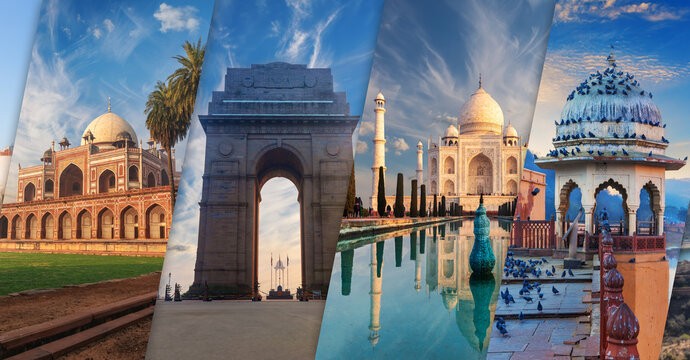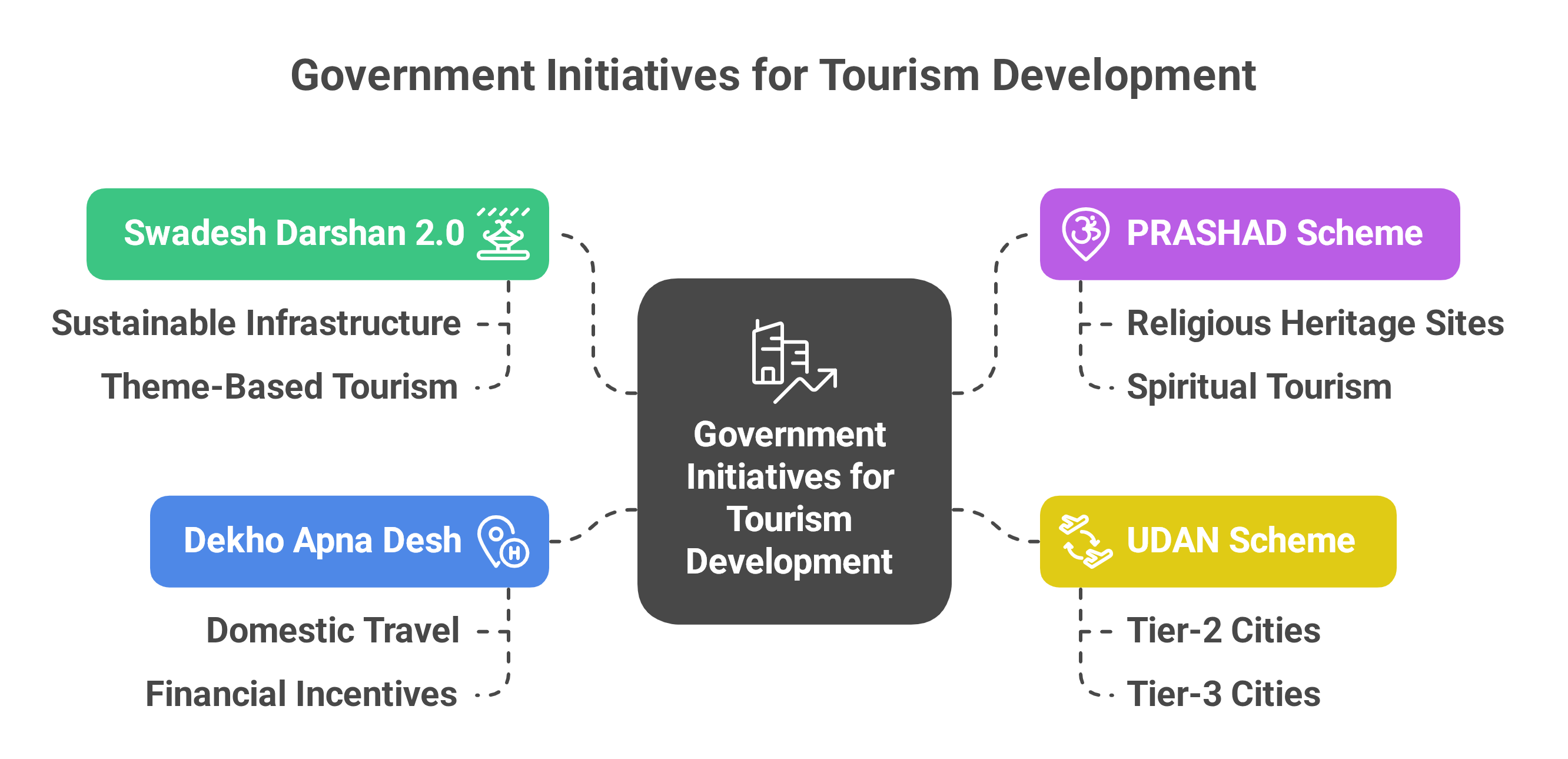Introduction:
Tourism is among the most labour-intensive industries in the world. Unlike sectors that rely heavily on machines or automation, tourism generates livelihoods directly for people — across transport, hospitality, food services, handicrafts, wellness, and entertainment. Its reach is both deep and wide, from highly skilled professionals in urban centres to semi-skilled youth in rural communities. Currently, tourism contributes about 5% of India’s GDP, compared to the global average of around 10%. Countries like Spain and the UAE, where tourism makes up about 12% of GDP, highlight what is possible when the sector is treated as a national growth priority. For India, this gap represents not a weakness but a massive opportunity.
- The recent decision by the United States to impose higher tariffs on select Indian is a timely reminder of the vulnerabilities that come with overdependence on any single trade relationship. However, one sector that holds vast untapped potential for India is tourism. Beyond being a showcase of our heritage and soft power, tourism can emerge as a powerful engine of economic growth, job creation, and foreign exchange earnings.
Current Status of Tourism in India:
- In 2024, India earned about $28 billion (₹2,45,000 crore) in foreign exchange from tourism. While impressive, this is only a small share of our true potential. A stronger inbound tourism sector would not only boost GDP but also act as a buffer against swings in merchandise trade.
- Meanwhile, outbound tourism is rising sharply. Over 28 million Indians travelled abroad in 2024, spending $28–31 billion, mostly on luxury, leisure, and unique experiences. Unless India builds comparable attractions at home, this money will continue to flow out.
- If India can raise tourism’s share in GDP from 5% to 10% over the next decade, the impact would be transformative. It could add $516 billion annually to the economy, create 40 million new jobs, and lift foreign exchange earnings to $130–140 billion a year. This would reshape India’s economic landscape, offering stability in a world of rising trade and geopolitical risks.
Diversity of Indian Tourism:
1. Cultural & Heritage Tourism – With 42 UNESCO World Heritage Sites, India ranks among the top globally. Cities like Varanasi, Jaipur, Hampi, and Khajuraho attract millions.
2. Nature & Eco-Tourism – From the Himalayas to Western Ghats, India is a biodiversity hotspot. Wildlife sanctuaries like Ranthambore, Gir, and Kaziranga are globally known.
3. Spiritual Tourism – India is home to Hindu pilgrimages (Kashi, Kedarnath), Buddhist sites (Bodh Gaya, Sarnath), Sikh shrines (Golden Temple), and Islamic heritage (Ajmer Sharif).
4. Medical Tourism – India is emerging as a global hub for affordable, high-quality medical procedures. In 2022, medical tourism generated $6 billion, with strong inflows from Africa, the Middle East, and South Asia.
5. Adventure Tourism – Trekking in Ladakh, river rafting in Rishikesh, scuba diving in Andaman, and desert safaris in Rajasthan are gaining traction.
6. Rural & Experiential Tourism – Programs like “Dekho Apna Desh” promote cultural immersion and homestays, highlighting local crafts and traditions.
Challenges in India’s Tourism Sector:
1. Infrastructure Gaps
-
- Tourism growth in India is limited by poor road, rail, and air connectivity, especially in remote destinations. At present, the country has about 1,80,000 branded hotel rooms and 1.5 million unbranded rooms, but industry estimates suggest that both categories must triple to meet future demand. Expanding this capacity is essential to remain competitive, maintain affordability, and position India as a venue for global events and conventions.
- Unlike goods exports, tourism is shaped not by foreign market policies but by domestic factors such as perception, infrastructure, and facilitation — areas where proactive action can yield big results.
2. Safety and Security Issues
-
- Concerns about harassment, theft, scams, and women’s safety significantly affect India’s global tourism image. Such risks discourage solo female travelers and many international visitors, undermining confidence in India as a safe and reliable destination.
- Concerns about harassment, theft, scams, and women’s safety significantly affect India’s global tourism image. Such risks discourage solo female travelers and many international visitors, undermining confidence in India as a safe and reliable destination.
3. Environmental Stress
-
- Unregulated tourist inflows into ecologically fragile regions, particularly the Himalayas, have led to habitat destruction, pollution, and overuse of natural resources.
- Yet, tourism is unique in combining economic growth with sustainability. Every rupee spent circulates through local economies — from crafts and transport to food services. Unlike heavy industries, it requires little resource extraction and, if managed responsibly, leaves a relatively low ecological footprint.
- India is naturally suited for wellness tourism, spiritual journeys, medical value travel, and cultural immersion. Ayurveda, yoga, pilgrimage circuits, and UNESCO heritage sites are strong assets. The challenge is ensuring consistent world-class packaging and presentation.
4. Seasonal Dependence
-
- Tourism in India is highly seasonal, leading to overcrowding during peak periods and underutilization in the off-season. This reduces overall profitability and strains infrastructure. The Char Dham Yatra in Uttarakhand is a clear example, where seasonal surges overwhelm local systems.
- Tourism in India is highly seasonal, leading to overcrowding during peak periods and underutilization in the off-season. This reduces overall profitability and strains infrastructure. The Char Dham Yatra in Uttarakhand is a clear example, where seasonal surges overwhelm local systems.
5. Slow Post-Pandemic Recovery
Global disruptions — from pandemics to trade wars — show the need for strong domestic resilience. Tourism is vital here because it:
· Creates demand that cannot be taxed at foreign borders.
· Generates jobs that cannot be outsourced or offshored.
· Builds national pride alongside prosperity.
Its multiplier effect is unmatched: investment in one hotel, airport, or heritage site stimulates an entire ecosystem of services, from transport to handicrafts.
Pathways to Growth:
· Developing World-Class Destinations: The Union Budget’s announcement of developing 50 destinations in partnership with states is an important step. Creating at least one world-class tourist destination in every state, blending infrastructure, sustainability, and branding, can help shift India’s global image from simply a “place to see” to a “place to experience.”
· Improving Travel Facilitation: Tourists value seamless experiences. Simplifying e-visas, reducing immigration queues, and ensuring smooth arrivals can make India far more attractive. With Indian airlines expected to add about 1,000 aircraft in the coming years, improved air connectivity will provide a decisive boost.
· Content and Digital Promotion: Tourism promotion today is no longer only about brochures and advertisements. The future lies in content-led campaigns, influencer engagement, and digital storytelling. Millions of creators already showcase India online; what is needed now is amplification through partnerships with global platforms and AI-driven curation.
· Unlocking Private Investment: Tourism development requires large investments in hotels, convention centres, ropeways, and roadside amenities. Expanding the sector’s inclusion in the Harmonised Master List of Infrastructure can attract private investors and encourage public-private partnerships (PPPs).
· Strengthening Domestic Tourism: Domestic tourism contributes 86% of the sector’s revenues. Campaigns like Dekho Apna Desh can be turned into a national movement, encouraging Indians to explore their own country. Affordable interstate travel and better connectivity can spread economic benefits more evenly across regions while deepening cultural understanding.
Government Initiatives:
· Swadesh Darshan 2.0: Focuses on sustainable, theme-based circuits (spiritual, eco, cultural). · PRASHAD Scheme: Pilgrimage Rejuvenation and Spiritual Heritage Augmentation Drive for infrastructure at iconic religious destinations. · Dekho Apna Desh: A campaign to encourage domestic tourism. · E-Visa Facility: Expanded to citizens of 171 countries, simplifying travel. · Adopt a Heritage Project: Engages corporates in maintaining heritage sites. · Incredible India 2.0: Branding India as a premium tourist destination through digital platforms. · National Tourism Policy (Draft 2022): Aims to make India a top five global destination by 2030 with a focus on digital tools, sustainable practices, and public-private partnerships. |
Conclusion:
The US tariffs may be beyond India’s control, but how we position our tourism sector is entirely in our hands. With its deep civilisational heritage, natural diversity, and vibrant culture, India already has what it takes to become one of the world’s leading tourism destinations.
| Main question: Tourism contributes around 5% of India’s GDP. Discuss the potential of tourism as a driver of economic growth, employment generation, and foreign exchange earnings in India. |








